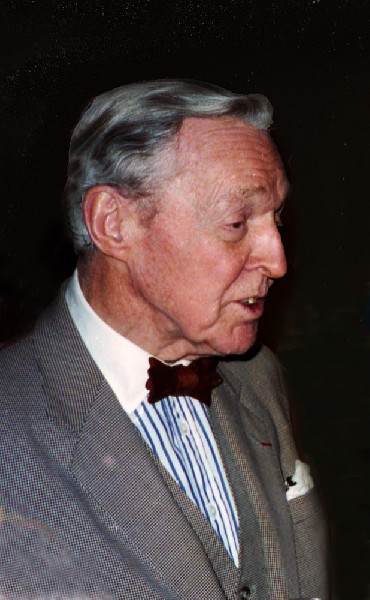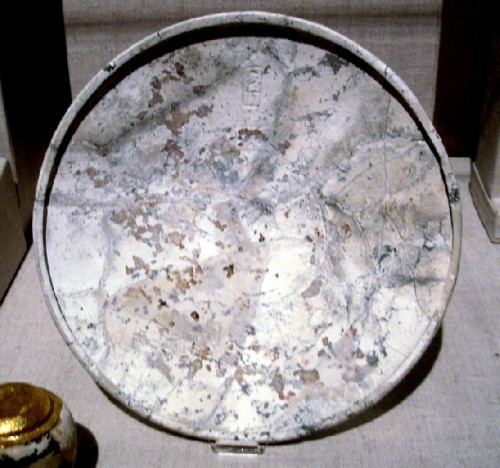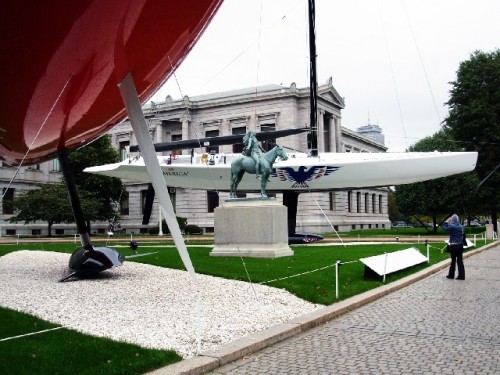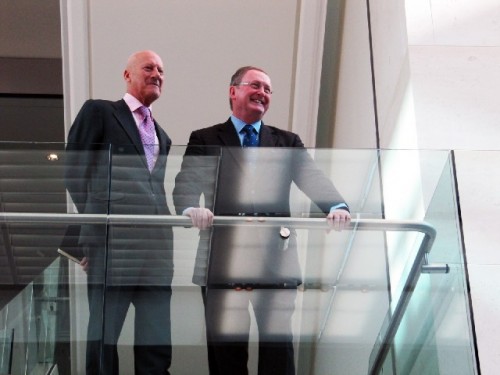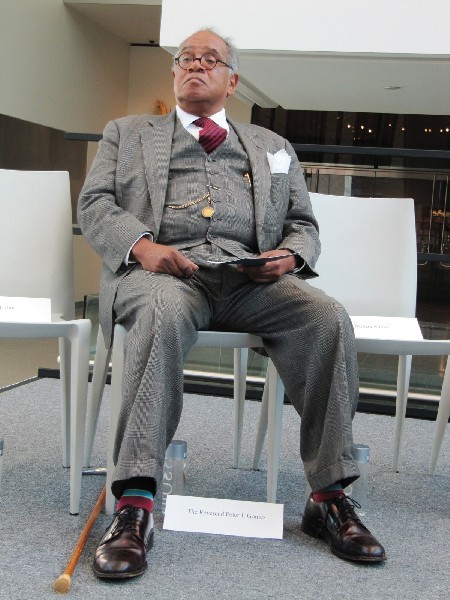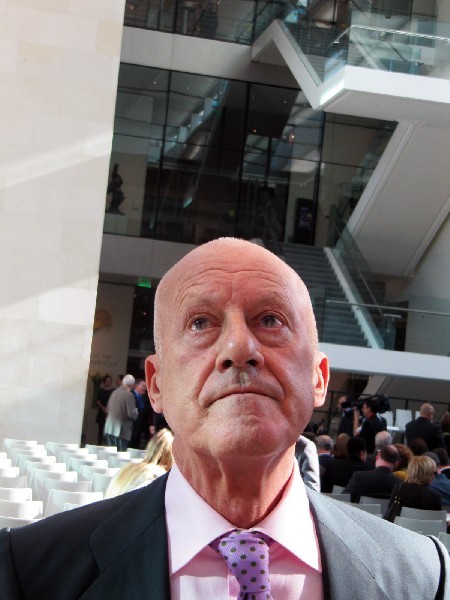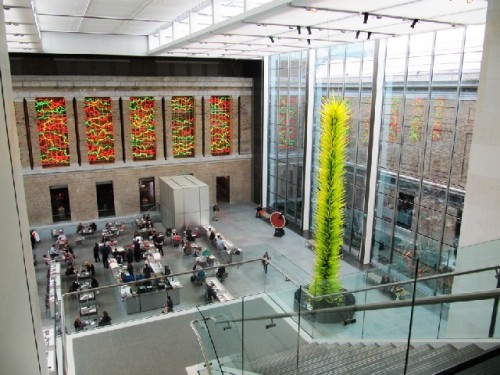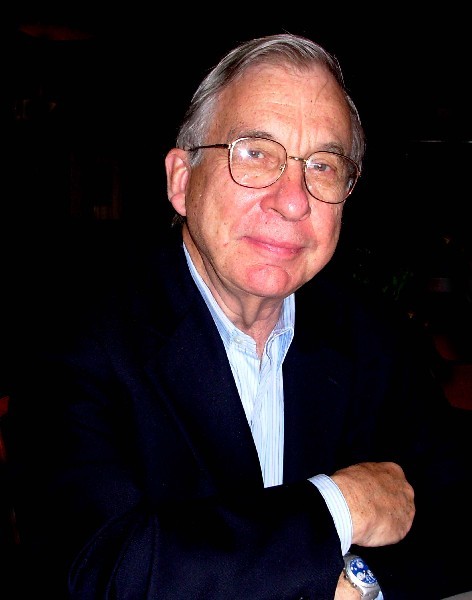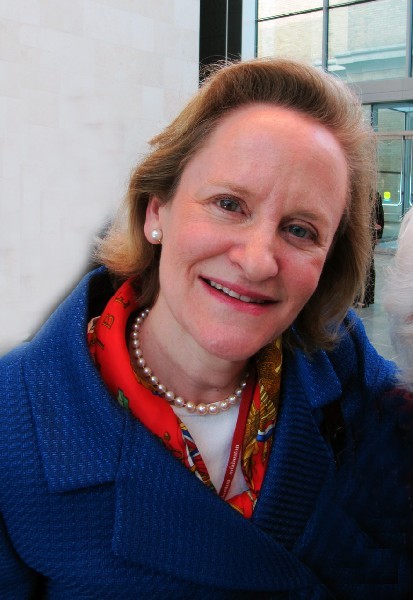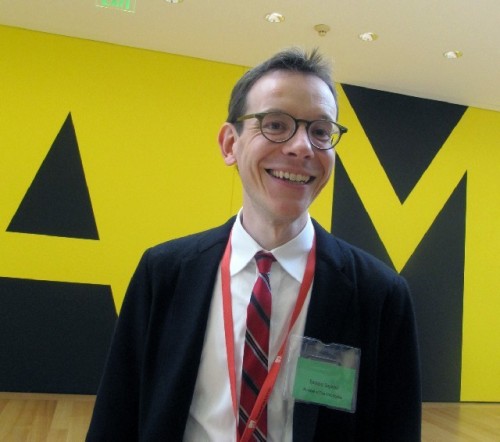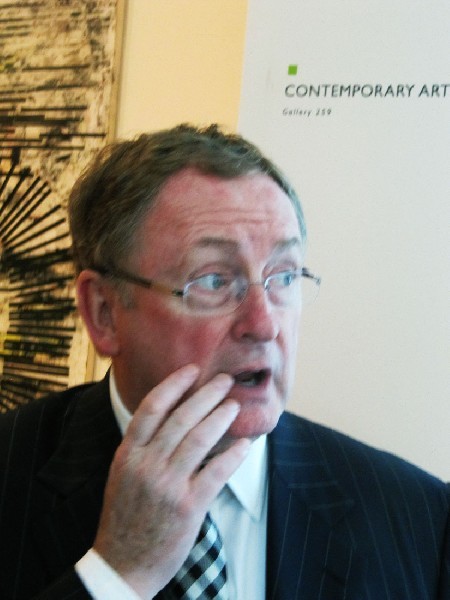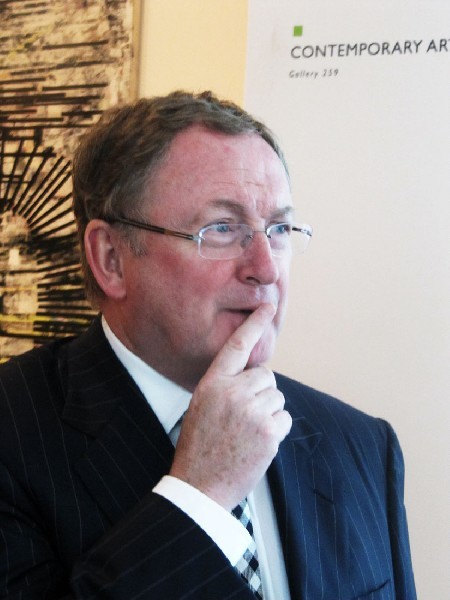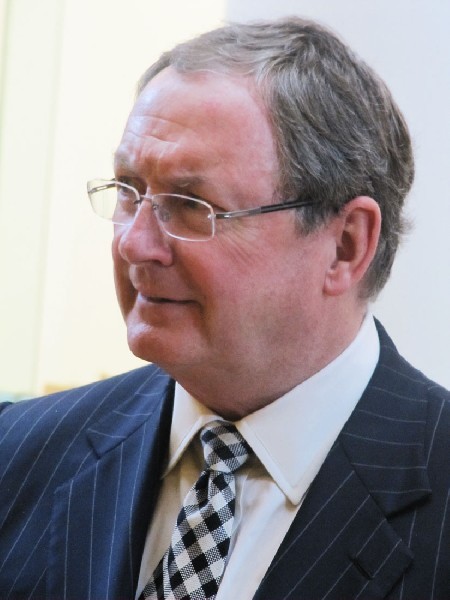Malcolm Rogers Retires from the MFA
More Autocrat than Aristocrat
By: Charles Giuliano - Feb 28, 2014
Museum of Fine Arts British born (1948) director, Malcolm Rogers, who has announced his retirement after some 19 years is a conundrum.
In moving the museum forward with massive renovation and construction as well as a vastly increased endowment, he will be remembered as the museum’s greatest and longest serving bricks and mortar director.
His critics feel that he has been a populist/ vulgarian and control freak. Under the mantra of One Museum he shook up departments and fired 18 key staff members as well as two distinguished curators during what was described as "The Boston Massacre."
Under my thumb best describes his management style resulting in an often mediocre exhibition program particularly in the realm of modern and contemporary art. Despite a reinstalled collection, and a respected contemporary curator, Edward Saywell, replacing one that was not, Cheryl Brutvan, in this field the MFA continues to lag far behind major American and international museums.
As former curator of American Art, Theodore E. Stebbins, Jr. commented in the 1970s "The Museum of Fine Arts is getting serious about the 20th century now that it is nearly over." There have been incremental gains since then particularly under the watch of Rogers.
The towering glass bobble by Dale Chihuly, a tchotchke that was acquired from the artist’s major retrospective, in the museum’s restaurant/ atrium in the new wing of the Art of the Americas, trumpets enduring evidence of Roger's alleged lack of taste.
This is the museum director who produced crowd pleasing exhibitions of celebrity photography by Herb Ritts and Yousuf Karsh, the British cartoon world of Wallace and Gromit, the cars of Ralph Lauren, a survey of guitars, the yachts, empty wine bottles and Native American souvenirs of billionaire William I. Koch.
The latter project revealed that Rogers had no qualms about flattering spoiled rich kids the better to squeeze coins from their pockets. There is not much evidence so far that Koch coughed up in proportion to his staggering wealth. During the administration of Jan Fontein, while curator of European Art at the MFA, John Walsh (later director of the Getty Museum) earned an annual consulting fee to buy work's for Koch's foundation. Some of these works were, for a time, anonymous loans to the MFA and other museums.
Koch's brothers (there are four) fund the far right and strive to tip the balance of American politics. David H. Koch and Charles G. Koch — the two brothers still with Koch Industries — are affiliated with the Koch Family Foundations. Annual revenues for Koch Industries have been "estimated to be one hundred billion dollars." They are known for funding of conservative causes and political campaigns. Their father, Fred C. Koch was a founder of the John Birch Society. Compared to which William is relatively benign with expensive toys. It must have been fun for him to park his America’s Cup vessels on the lawn in front of the museum’s Huntington Avenue entrance.
The MFA presented 375 exhibits during Rogers’s tenure, showing everything from ancient Chinese art to Impressionist masterpieces. The museum acquired some 67,000 works of art, including a more-than-$20 million painting by Edgar Degas, “Duchessa di Montejasi with Her Daughters, Elena and Camilla."
Don’t get me wrong. I liked Malcolm. Who wouldn’t? Unless you worked for him.
Oxford educated and well dressed Rogers is utterly charming. But in a Downton Abbey sense of not to the manor born.
During our first of numerous interviews and exchanges Malcolm told me that he was from the Midlands and a long line of butchers. He was proud of being able to process a hog from ears and snout to sausages.
“But please don’t call me the ‘Butcher of the MFA’ " he asked.
Not long after, however, he was exactly that in a metaphorical sense presiding over the curatorial "massacre." He also engaged in a long and contentious contract negotiation with the union of museum guards. It got ugly.
Looking back, however, to an MFA which immediately before Rogers was mostly enervating and demoralized, he served the mandate of the board and was the right (hatchet) man for the job.
When Alan Shestack (1987-1993) took over I asked what it was like to follow Jan Fontein (1972 acting director, 1975-1987 director)?
“It’s like jumping onto a fast moving train” Shestack told me in a feature for Art New England. Several years later his lackluster administration derailed. He moved on to a position as deputy director of the National Gallery.
The museum had long languished in second gear and was in need of a jump start.
My relationship with the MFA started as a teenager in the 1950s. While a student at nearby Boston Latin School I liked to bike over after classes and roam the museum. After college my first job was as an intern in the Department of Egyptian and Near Eastern art (1964-1966) reporting to William Stevenson Smith.
Working in the basement storage which I cleaned and renovated after decades of neglect I was trained to sort and restore early dynastic stone vessels. One day I was surprised when a guard dropped in stating that “Mr. Rathbone has requested that you turn down your radio.” In the solitary confinement of the vast basement I tuned in the soul station WILD.
Perry T. Rathbone (Director: 1955-1972) was old school. With a BA from Harvard Perry was well connected moving from St. Louis to Boston. In a book by his daughter, Belinda, for which I was interviewed, she will argue that Perry did a lot to modernize and update the Brahmin institution.
Later, as a staff member of Boston After Dark (Boston Phoenix) and the Boston Herald Traveler I got to know and like Perry. I scooped the acquisition of the alleged Raphael portrait of the young Eleanora Gonzaga (heavily restored, misattributed and stolen from Italy) as well as the appointment of Kenworth Moffett as the museum’s first curator for modern and contemporary art.
When Perry and his bag man, Hans Swarzenski, got caught smuggling, as did the Met’s director, Thomas Hoving even more outrageously, Rathbone was forced to step down. But graciously with a year of farewells as well as a major exhibition “The Rathbone Years.”
What followed was a major pratfall.
As Belinda discussed with me, and surely will be elaborated in her book, there was a real power struggle between her father and the business man (Underwood CEO) George Seybolt then chairman of the board.
Under the old paradigm museum directors were both chief curator and CEO. Seybolt represented a growing trend of mega museums to separate those functions. Now retired Met director, Philippe de Montebello, was, arguably, the last of the holdouts.
Tom Krens ushered in a new paradigm as director the Guggenheim museums. He combined an MFA with an MBA. Under his watch the Guggenheim executed a strategy of global satellites and franchises. Even the MFA followed with the establishment of an MFA branch in Nagoya, Japan with a pay-per-view policy. As well as marketing extended loans of masterpieces from the collection.
During the search for Rathbone’s replacement Seybolt hired, without consulting the board, an obscure museum director, Merrill Rueppell, then in Houston. Immediately things went badly as the museum's senior curators, a renowned fiefdom, deemed that they were all more distinguished and qualified than the director they reluctantly served under.
The curators were clandestine sources for an “Et tu Brute” feature by Robert Taylor in the Sunday edition of the Boston Globe. The accompanying illustration depicted Rueppell as an ersatz Don Quixote fighting windmills. The piece announced follow up articles that week.
They never ran. Taylor’s Sunday piece delivered a knockout blow and Rueppell was fired. I spoke with him by phone and he remained in the area for some time on a very generous severance package.
In the old order department heads were inmates running the asylum. Seated at the council table their power was ranked by the wealth and influence of the departments. The deepest pockets and greatest global prestige resided with Jan Fontein of the Department of Asiatic Art.
He was a leader of the cabal that ousted Rueppell. But the role of Taylor’s “Deep Throat” was likely Cornelius Vermule the socially prominent, scholar of Greek and Roman Art. I knew him well as his office adjoined ours. He referred to us as the Gyppos.
Cornelius was a gentleman with magnificent wit. When I was closely examining a kylix depicting men performing anal sex Cornelius leaned over and asked if I read ancient Greek? He then translated the inscription as “Hold Still.” It was later my pleasure to participate in his playful graduate seminar.
The capo di tutti capi, as acting director Fontein stabilized the museum and its hegemony of curators. His greatest accomplishment, not surprisingly, were in the Far East with amazing exhibitions and stunning acquisitions such as a Korean crown. As publicist and confidante, Clementine Brown, told me in Japan he was regarded as a “Shogun.”
While the MFA moved forward, including massive renovation of the Evans Wing, Fontein proved over-matched by administrative demands. The museum was protested by African Americans resulting in an adjunct curator Barry Gaither and liaison with The National Center for African American Art. There was a PC exhibition African American Artists; New York and Boston. Under Rogers there have been efforts to increase holdings in the permanent collection.
Allegedly, there was a meltdown of Fontein during a board meeting. There was a pledge of support but clearly changes were called for. Elevating a curator with little or no major administrative experience to run a complex museum had been a mixed experiment.
Reaching across the pond to Rogers was a bold move. While clearly a talented and ambitious curator and administrator, at mid-career, he had been passed over for the top spot at the National Portrait Gallery where he had been deputy director and deputy keeper. He area of specialty is 16th through early 18th century British portraiture. At the MFA he dabbled in contemporary art.
It is the norm that the top positions of British cultural institutions are designated for titled aristocracy. Rogers has seized opportunities in America where a British accent and advanced degree from Oxford equate to ersatz aristocracy. He has been masterful in playing the part.
Recently Rogers sold his 5,500-square-foot house in Brookline for a condominium in Chestnut Hill half that size. Late in 2012, he also bought a small house in West Oxford, England. We assume that Rogers, now 65, will spend his golden years pond hopping first class. While "retired" he is likely to enjoy many opportunities.
Under the headline “Malcolm Rogers Talks Smugly After Boston Massacre” on 9/13/99 Hilton Kramer in the New York Observer reported the dismantling and consolidation of the museum’s curatorial departments.
“…on June 25, Mr. Rogers announced his plans for what was called “an organizational restructuring” of the M.F.A., designed to meet the needs of a new strategic plan. What these plans would entail was made immediately apparent when 18 members of the museum staff-including two senior curators-were fired on the spot. The curators marked for termination-Jonathan Fairbanks, with 28 years of experience as the curator of the M.F.A.’s Department of American Decorative Arts, and Ann Poulet, with 20 years as the museum’s curator of European Decorative Arts-were promptly taken by security guards to the personnel office, where they were obliged to hand over their keys and museum passes and told to clean out their offices and be out of the building by 3 P.M. As severance compensations, they were reportedly offered the minimum the law requires.
“This brutal treatment seems also to have been accompanied by a good deal of unconscionable dissimulation. According to a page 1 report in The Beacon Hill/Back Bay Chronicle , a Boston weekly, on Aug. 31, 'At the time of the dismissal, the curators were told that the positions were being abolished by vote of the trustees. However, within the month, Jeffrey Munger, who offered his resignation as associate curator of European Decorative Arts, was told he would be offered the [European Decorative Arts] curatorship. He declined, citing dismay over the drift of curatorial affairs over the past five years [of Mr. Rogers' tenure as director].' Three positions were cut, which would have hampered its work severely."
There were immediate repercussions. Boston University American Art professor, Patricia Hills, called for his resignation. There was a counter attack from the museum but Hills held onto her job from which she intends to retire next year.
As Kramer reported “That was promptly followed by a letter to Jon Westling, the president of Boston University, demanding that he take some action against Professor Hills for writing such a letter to the M.F.A. That letter is reported to have been written by Barbara Warren, an employee of Crosby Advisors, part of Fidelity Investments, whose head, Edward Johnson, is an honorary trustee of the M.F.A., and whose wife, Elizabeth, is head of the museum’s collections committee.
“Much to President Westling’s credit, he responded to Barbara Warren’s attempted reprisal as follows: 'Boston University is not, as you put it, a ‘public institution,’ but a private university. We do not censor our faculty members’ mail or attempt to control their expressions of opinion.… On the question of whether a university should ‘countenance’ a faculty member in art history expressing views (‘criticizing and second-guessing’) about the policies of the Museum of Fine Arts, I must admit that your objection astonishes me. You may disagree with Professor Hills’ professional judgment, but to object to her right to express that judgment is surely counter to the spirit that ought to animate both universities and art museums.' ”
Reached for comment on the retirement of Rogers Professor Hills replied to the Globe “When told of the impending retirement, Patricia Hills, a Boston University professor of American Art and longtime Rogers critic, responded with: 'Oh, yay (sic)…The problem with Malcolm is he did not know how to deal with strong curators, so he fired them.' "
Toward the goal of One Museum Rogers dismantled the warren of departments and consolidated them into a few mega departments reporting directly to him. One of these is Art of the Americas. The position of chair was offered to Stebbins who declined and decamped to the Fogg Art Museum of Harvard University.
The position was filled by Elliott Bostwick Davis.
Now heading off for the good life of retirement, before turning over the keys to the castle, perhaps Malcolm is enjoying the last laugh on his critics.
“Who wants to be criticized?” Rogers told the Globe “But my job is not to be diverted by criticism.”
Nothing succeeds like success. In this regard he leaves a legacy that will be impossible to match. Inside and out the MFA today is a singular monument to his vision and leadership. He took a great but foundering institution and restored it to the front ranks of world museums.
Like the Red Sox and the Yankees the MFA has often competed with its greater and more powerful rival the Met. It will never again be on that level but in designated areas the MFA is second to none. The efforts of Rogers enhanced that depth and prestige.
Under Rogers the endowment rose from $180 million to $602 million. Since 2009, 97 of 143 galleries have been built or renovated. The museum raised $504 million toward Lord Norman Foster’s Art of the Americas wing. It increased the size of the MFA by 28 percent, adding 53 new galleries and 133,500 square feet. A year later, the museum opened the renovated west wing as the Linde Family Wing for Contemporary Art.
Those are indeed astonishing accomplishments. Rogers on contemporary art.
Every time I walk by that towering glass piece by Chihuly, which would be right at home in the lobby of a Vegas casino, it reminds us that for all of Roger's astonishing accomplishments, taste and aesthetic refinement were not among them.
In the long run Rogers, who prospered in the Colonies, was more Downstairs than Upstairs.
Rebuttal by art critic David Bonetti.
Sidebar on Raphael, Rathbone and Reuppel.
Boston Globe coverage by Sebastian Smee.


